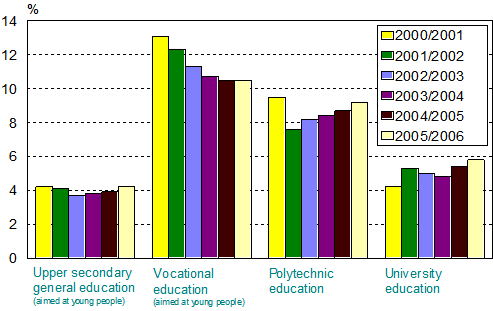Published: 11 March 2008
Discontinuation of education increased most in polytechnic education
Six per cent of students attending education leading to a qualification or degree discontinued their studies and did not resume them in any education leading to a qualification or degree during the 2005/2006 academic year. If discontinuation of education is examined by sector of education, upper secondary general education aimed at young people was discontinued by 4 per cent and vocational education by 10.5 per cent of students. Polytechnic education was discontinued by 9 per cent and university education by 6 per cent of students. Compared to the previous year, discontinuation increased slightly in all sectors of education except for vocational education where it remained unchanged. In recent years, discontinuation has increased most in polytechnic education.
Some of the discontinuers resumed studies in another sector of education, e.g. an upper secondary general school student in vocational education. Taking into consideration the students having changed sector of education lowers the percentages on discontinuation. This happened particularly in upper secondary general education and polytechnic education.
Male students discontinued studies more frequently than female students. The difference between the genders in discontinuation of education was largest in polytechnic education where the rate of discontinuation was over 11 per cent among male students and 7.5 per cent among female students. In vocational education aimed at young people the rates of discontinuation were highest in the fields of natural resources and the environment, and natural sciences, in polytechnic education in the fields of natural sciences, and transport and communications, and in university education also in the field of natural sciences.
In upper secondary general education and in vocational education aimed at young people, students over the age of 19 discontinued education clearly more frequently than their juniors. In university education, the rate of discontinuation was higher than the average among students aged over 28. Age and rate of discontinuation did not seem to correlate quite so direct in polytechnic education.
Vocational education intended for young people was discontinued more often than the average by students of special education, of whom 18 per cent discontinued their studies in the 2005/2006 academic year. Exclusive of students of special education, the rate of discontinuation in vocational education was 10 per cent. Approximately 11 per cent of the students of vocational education aimed at young people were students of special education.
Discontinuation of education leading to a qualification or degree by sector of education in the academic year 2005/2006
| Sector of education | Discontinued in own sector of education |
Changed sector of education |
Discontinued completely education leading to a qualification or degree |
| % | % | % | |
| Upper secondary general education (aimed at young people) |
4,2 | 2,1 | 2,1 |
| Vocational education (aimed at young people) |
10,5 | 1,1 | 9,4 |
| Polytechnic education | 9,2 | 2,3 | 6,9 |
| University education | 5,8 | 0,7 | 5,0 |
| Total | 7,4 | 1,5 | 5,9 |
Discontinuation of education in upper secondary general, vocational, polytechnic and university education in the academic years from 2000/2001 to 2006/2005

Source: Education Statistics. Statistics Finland.
Inquiries: Ms Riikka Rautanen +358 9 1734 2375, koulutus.tilastot@stat.fi
Director in charge: Mr Jari Tarkoma
- Tables
-
Tables in databases
Pick the data you need into tables, view the data as graphs, or download the data for your use.
Last updated 11.3.2008
Official Statistics of Finland (OSF):
Discontinuation of education [e-publication].
ISSN=1798-9302. 2006. Helsinki: Statistics Finland [referred: 12.12.2025].
Access method: http://stat.fi/til/kkesk/2006/kkesk_2006_2008-03-11_tie_001_en.html

